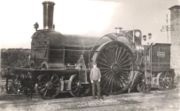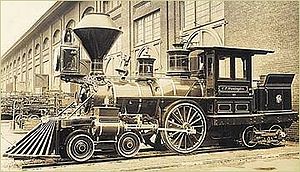.gif)
4-2-4 (locomotive)
Encyclopedia
In Whyte notation
, a 4-2-4 is a steam locomotive
that has a four-wheel leading truck, one powered driving axle
and a four-wheel unpowered trailing truck.
Other equivalent classifications are:
UIC classification
: 2A2 (also known as German classification and Italian classification)
French classification: 212
Turkish classification
: 15
Swiss classification: 1/5
 This most unusual wheel arrangement was limited to tank locomotives.
This most unusual wheel arrangement was limited to tank locomotives.
supplied to the broad gauge
Bristol and Exeter Railway
in 1853. They were designed by James Pearson
, and featured single large flange
less driving wheels and two supporting bogie
s. The water was carried in both well and back tanks
. Three classes were distinguished by the size of driving wheel; the original 9 feet (2.7 m) wheels were replaced by smaller ones on later designs. The type was also used on an experimental locomotive
by William Dean of the Great Western Railway
1881. It did little work and was prone to derailment
. It was rebuilt as a 2-2-2 tender locomotive in 1884.
Dugald Drummond
of the London and South Western Railway
built a 4-2-4T LSWR F9 class combined locomotive and inspection saloon in 1899. It was little used after Drummond's death in 1912.
 C. P. Huntington
C. P. Huntington
was one of three identical 4-2-4 locomotives which were the first locomotives purchased by Southern Pacific Railroad
in 1863, for use on light commuter services in the Sacramento area. They were soon deemed too light and lacking in adhesion for most short trains, due to their single driving wheel axle that did not have the full weight of the engine's rear due to the trailing truck. As a result they were not used frequently except when absolutely needed. Also the short water tank on the Forney type
frame prevented the locomotives from traveling any moderate distance without consuming all of the water. A sister engine, T. D. Judah
was built by the Cooke Locomotive Works in 1863 for a railroad that was unable to pay for it and purchased by the Central Pacific Railroad
. It was rebuilt as a 4-2-2
in 1872.
Whyte notation
The Whyte notation for classifying steam locomotives by wheel arrangement was devised by Frederick Methvan Whyte and came into use in the early twentieth century encouraged by an editorial in American Engineer and Railroad Journal...
, a 4-2-4 is a steam locomotive
Steam locomotive
A steam locomotive is a railway locomotive that produces its power through a steam engine. These locomotives are fueled by burning some combustible material, usually coal, wood or oil, to produce steam in a boiler, which drives the steam engine...
that has a four-wheel leading truck, one powered driving axle
Driving wheel
On a steam locomotive, a driving wheel is a powered wheel which is driven by the locomotive's pistons...
and a four-wheel unpowered trailing truck.
Other equivalent classifications are:
UIC classification
UIC classification
The UIC classification of locomotive axle arrangements describes the wheel arrangement of locomotives, multiple units and trams. It is set out in the International Union of Railways "Leaflet 650 - Standard designation of axle arrangement on locomotives and multiple-unit sets". It is used in much...
: 2A2 (also known as German classification and Italian classification)
French classification: 212
Turkish classification
Turkish classification
In the Turkish classification system for railway locomotives, the number of powered axles are followed by the total number of axles. It is identical to the Swiss system except that the latter places a slash between the two numbers.Thus0-6-0 becomes 33...
: 15
Swiss classification: 1/5
History

UK usage
The type appears to have first been used on 14 locomotivesBristol and Exeter Railway 4-2-4T locomotives
The 14 Bristol and Exeter Railway 4-2-4T locomotives were broad gauge 4-2-4T steam locomotives built to three different designs. The first entered service in 1853...
supplied to the broad gauge
Broad gauge
Broad-gauge railways use a track gauge greater than the standard gauge of .- List :For list see: List of broad gauges, by gauge and country- History :...
Bristol and Exeter Railway
Bristol and Exeter Railway
The Bristol & Exeter Railway was a railway company formed to connect Bristol and Exeter.The company's head office was situated outside their Bristol station...
in 1853. They were designed by James Pearson
James Pearson (engineer)
This article is about James Pearson, British railway engineer. For other people of the same name see James Pearson.James Pearson was a 19th century English railway engineer...
, and featured single large flange
Flange
A flange is an external or internal ridge, or rim , for strength, as the flange of an iron beam such as an I-beam or a T-beam; or for attachment to another object, as the flange on the end of a pipe, steam cylinder, etc., or on the lens mount of a camera; or for a flange of a rail car or tram wheel...
less driving wheels and two supporting bogie
Bogie
A bogie is a wheeled wagon or trolley. In mechanics terms, a bogie is a chassis or framework carrying wheels, attached to a vehicle. It can be fixed in place, as on a cargo truck, mounted on a swivel, as on a railway carriage/car or locomotive, or sprung as in the suspension of a caterpillar...
s. The water was carried in both well and back tanks
Tank locomotive
A tank locomotive or tank engine is a steam locomotive that carries its water in one or more on-board water tanks, instead of pulling it behind it in a tender. It will most likely also have some kind of bunker to hold the fuel. There are several different types of tank locomotive dependent upon...
. Three classes were distinguished by the size of driving wheel; the original 9 feet (2.7 m) wheels were replaced by smaller ones on later designs. The type was also used on an experimental locomotive
GWR Dean experimental locomotives
During the 1880s William Dean constructed a series of experimental locomotives to test various new ideas in locomotive construction for the Great Western Railway.-No. 1:...
by William Dean of the Great Western Railway
Great Western Railway
The Great Western Railway was a British railway company that linked London with the south-west and west of England and most of Wales. It was founded in 1833, received its enabling Act of Parliament in 1835 and ran its first trains in 1838...
1881. It did little work and was prone to derailment
Derailment
A derailment is an accident on a railway or tramway in which a rail vehicle, or part or all of a train, leaves the tracks on which it is travelling, with consequent damage and in many cases injury and/or death....
. It was rebuilt as a 2-2-2 tender locomotive in 1884.
Dugald Drummond
Dugald Drummond
Dugald Drummond was a Scottish steam locomotive engineer. He had a career with the North British Railway, LB&SCR, Caledonian Railway and London and South Western Railway...
of the London and South Western Railway
London and South Western Railway
The London and South Western Railway was a railway company in England from 1838 to 1922. Its network extended from London to Plymouth via Salisbury and Exeter, with branches to Ilfracombe and Padstow and via Southampton to Bournemouth and Weymouth. It also had many routes connecting towns in...
built a 4-2-4T LSWR F9 class combined locomotive and inspection saloon in 1899. It was little used after Drummond's death in 1912.
US usage

C. P. Huntington
C. P. Huntington is a 4-2-4T steam locomotive currently on static display at the California State Railroad Museum in Sacramento, California, USA. It is the first locomotive purchased by the Southern Pacific Railroad, carrying that railroad's number 1. The locomotive is named in honor of Collis P...
was one of three identical 4-2-4 locomotives which were the first locomotives purchased by Southern Pacific Railroad
Southern Pacific Railroad
The Southern Pacific Transportation Company , earlier Southern Pacific Railroad and Southern Pacific Company, and usually simply called the Southern Pacific or Espee, was an American railroad....
in 1863, for use on light commuter services in the Sacramento area. They were soon deemed too light and lacking in adhesion for most short trains, due to their single driving wheel axle that did not have the full weight of the engine's rear due to the trailing truck. As a result they were not used frequently except when absolutely needed. Also the short water tank on the Forney type
Forney locomotive
The Forney is a type of tank locomotive patented by Matthias N. Forney between 1861 and 1864. Forney locomotives include the following characteristics:* An 0-4-4T wheel arrangement, that is four driving wheels followed by a truck with four wheels....
frame prevented the locomotives from traveling any moderate distance without consuming all of the water. A sister engine, T. D. Judah
T. D. Judah
T. D. Judah was the name of a 4-2-2 steam locomotive owned by the Central Pacific Railroad. It was named in honor of the railroad's first chief engineer, Theodore Dehone Judah, who surveyed a passable route over the Sierra Nevada Mountains for the Transcontinental Railroad.- History and career...
was built by the Cooke Locomotive Works in 1863 for a railroad that was unable to pay for it and purchased by the Central Pacific Railroad
Central Pacific Railroad
The Central Pacific Railroad is the former name of the railroad network built between California and Utah, USA that formed part of the "First Transcontinental Railroad" in North America. It is now part of the Union Pacific Railroad. Many 19th century national proposals to build a transcontinental...
. It was rebuilt as a 4-2-2
4-2-2
Under the Whyte notation for the classification of steam locomotives, 4-2-2 represents the wheel arrangement of four leading wheels on two axles, two powered driving wheels on one axle, and two trailing wheels on one axle....
in 1872.

